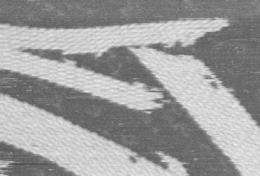Researchers demonstrate possible primitive mechanism of chemical info self-replication

(Phys.org) -- When scientists think about the replication of information in chemistry, they usually have in mind something akin to what happens in living organisms when DNA gets copied: a double-stranded molecule that contains sequence information makes two new copies of the molecule. But researchers at the California Institute of Technology (Caltech) have now shown that a different mechanism can also be used to copy sequence information.
In this alternate version, tiny DNA tile crystals consisting of many copies of a piece of information are first grown, then broken into a few pieces by mechanically-induced scission, or force. The new crystal bits contain all the information needed to keep copying the sequence. Each piece then begins to replicate its information and grow until broken apart again—without the help of enzymes, an essential ingredient in biological sequence replication. In some ways, the new system is reminiscent of Goethe's poem, The Sorcerer's Apprentice, in which the apprentice smashes a magic mop with an axe, producing many exact replicas of the sweeper, all programmed to do the same job.
"The genome-copying mechanism used by cells requires tight control between the separation of DNA strands and the copying process," explains study lead author Rebecca Schulman, an assistant professor at Johns Hopkins University who was a graduate student at Caltech when the research began.
"But no such coordination is required in the system we designed, which makes it simpler in many ways," she says. "This suggests that there may be other mechanisms of copying information that follow this method using chemistry that could be simpler than the process cells use. What we showed in the paper was a capacity to take a given chemical message—a sequence of 1s and 0s—and make more copies of that message through a new, designed self-replication process."
The findings were reported in a recent issue of the Proceedings of the National Academy of Sciences (PNAS).
The idea that crystals can self-replicate was first presented by organic chemist and molecular biologist Graham Cairns-Smith in 1965. He proposed, as well, that such crystals might have been the first chemical self-replicators capable of Darwinian evolution. His theory was controversial at the time, and his ideas have never gained widespread support. But according to Erik Winfree, professor of computer science, computation and neural systems, and bioengineering at Caltech and senior author on the PNAS paper, this new research shows that Cairns-Smith's hypothesis on the origin of life is demonstrably more plausible than previously thought.
"Overall, we found that his principles and mechanisms are sound, and although we didn't experimentally demonstrate his theory all the way, self-replication via crystal growth and scission should be sufficient for Darwinian evolution," he says. "This is because DNA tile crystals can be programmed to process information during growth, allowing them to adapt to their environment. Our findings could even form the basis of novel molecular technologies for making complex self-replicating nanoscale objects."
Their new research found that it is possible to design a mechanism for copying chemical information very accurately without relying on biological enzymes to assemble and separate sequence copies. Instead, the researchers relied only on simple kinds of attachments—molecular binding and unbinding reactions that they designed—and mechanical forces.
Having shown that information can be made to chemically self-replicate, says Schulman, the question becomes, what kinds of messages can be copied in this way?
"Our theoretical work suggests that not just linear sequences but also patterns in two dimensions, similar to wallpaper patterns that repeat every so often, could also be replicated," she says.
The crystals used in the study simply copied information verbatim from layer to layer as they grew, which in itself is insufficient to kick-start a Darwinian evolutionary process. But crystal growth that produces complex patterns resulting in 2- or 3-dimensional structures would, in this context, correspond to a rudimentary "genotype-phenotype" relationship, thereby enriching the Darwinian evolutionary process by introducing complex forms that would be subject to selective pressures, Winfree says.
"Our findings show that there is a bewildering variety of imaginable ways that chemical systems could self-replicate and evolve," he says. "This really puts into question whether or not the way biology does things now is the only possible way that life could be organized on a molecular level."
The PNAS study, "Robust self-replication of combinatorial information via crystal growth and scission," was funded by the Miller Institute of Basic Science, the National Science Foundation, and a National Aeronautics and Space Administration astrobiology grant. Bernard Yurke, a Distinguished Research Fellow at Boise State in Idaho, is also a coauthor of the paper.
Journal information: Proceedings of the National Academy of Sciences
Provided by California Institute of Technology















